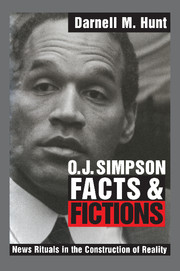Book contents
- Frontmatter
- Contents
- List of figures
- List of tables
- Acknowledgments
- Introduction: Knowing O.J.
- Part I Theory
- Part II News construction
- Part III Audience reception
- 7 Raced ways of seeing O.J.
- 8 Raced ways of seeing O.J. – revisited
- Part IV Conclusions
- Appendix 1 Page-one narratives, Los Angeles Times, January 25–October 4, 1995
- Appendix 2 Page-one O.J. narratives, Los Angeles Sentinel, January 25–October 5, 1995
- Appendix 3 Emerging discussion themes, by group, March 30, 1995
- Appendix 4 Emerging discussion themes, by group, August 1, 1995
- Appendix 5 Transcript of Primetime text
- Appendix 6 Transcript of KTLA text
- Appendix 7 Logistic regression of perceptions about Simpson's innocence or guilt on race, gender, education, family income, interviewer race, and perceptions of criminal justice system bias
- Notes
- References
- Index
8 - Raced ways of seeing O.J. – revisited
Published online by Cambridge University Press: 22 September 2009
- Frontmatter
- Contents
- List of figures
- List of tables
- Acknowledgments
- Introduction: Knowing O.J.
- Part I Theory
- Part II News construction
- Part III Audience reception
- 7 Raced ways of seeing O.J.
- 8 Raced ways of seeing O.J. – revisited
- Part IV Conclusions
- Appendix 1 Page-one narratives, Los Angeles Times, January 25–October 4, 1995
- Appendix 2 Page-one O.J. narratives, Los Angeles Sentinel, January 25–October 5, 1995
- Appendix 3 Emerging discussion themes, by group, March 30, 1995
- Appendix 4 Emerging discussion themes, by group, August 1, 1995
- Appendix 5 Transcript of Primetime text
- Appendix 6 Transcript of KTLA text
- Appendix 7 Logistic regression of perceptions about Simpson's innocence or guilt on race, gender, education, family income, interviewer race, and perceptions of criminal justice system bias
- Notes
- References
- Index
Summary
In the four months separating the first and second interviews (March 30–August 1, 1995), much had happened in the Simpson case. Prosecutors had presented the final twenty witnesses of their case-in-chief and Simpson's defense team had presented thirty-three of the fifty-three witnesses it would eventually call (Schmalleger 1996). During this period, a multitude of LAPD, California Department of Justice, and FBI agents and criminalists would testify that physical evidence – blood DNA, human hairs, and shoe prints – conclusively tied Simpson to the murder scene, and the victims to blood found in his Bronco and on items at his Rockingham home. Defense attorneys, of course, had endeavored to discredit and/or impeach these witnesses, their efforts reaching a crescendo, perhaps, with defense attorney Barry Scheck's much-heralded cross-examination of LAPD criminalist Dennis Fung (April 3, 5, 11–14, and 17–18, 1995).
Finally, in what many observers up to that point had described as the nadir of the prosecution's case, prosecutor Christopher Darden asked Simpson to try on the bloody gloves in court. Simpson stood before the jury, wrestled with pulling the leather gloves over the latex ones protecting his hands, and finally announced that the gloves did not fit (June 15–16, 1995). Although prosecutors would suggest that Simpson was acting – and later offer testimony indicating the gloves had shrunk and that the latex gloves further altered the fit – many trial observers felt the impression had already been made: the gloves did not fit.
- Type
- Chapter
- Information
- O. J. Simpson Facts and FictionsNews Rituals in the Construction of Reality, pp. 216 - 246Publisher: Cambridge University PressPrint publication year: 1999



